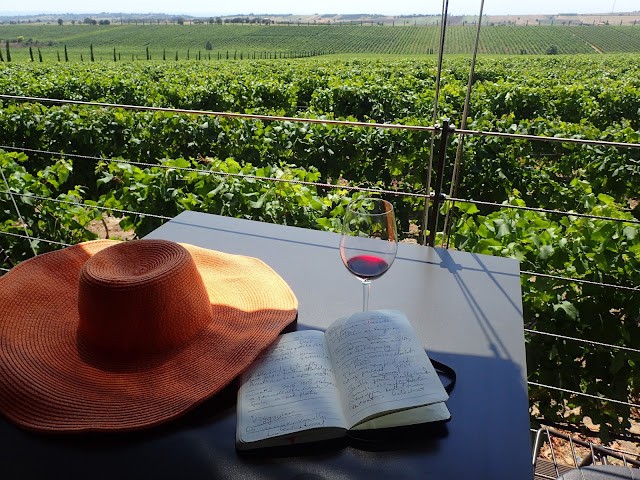But it plays its role, in the mildness of the winters and in the temperate summers cooled by its breezes. The soil is sandy, rich in sea fossils. The vineyards teem with life- 28 species of birds thrive among the vines. Come mid-August, these vines will all be harvested by hand. Good wine needs good grapes, and harvesters with a careful hand and skilled eye.
 |
| Suggestion of a vine by Kostas Tsoklis |
 |
| Moon by Kostas Varotsos |
Of the varieties in Greece, Malagousia- making a white wine full of ripe fruits and fragrance and flowers- is special. Well, this delicious grape was nearly lost to time(!). A professor at the Aristotle University rescued it, and Vangelis Gerouvasileiou was the first to vinify it- an important contribution to the world of wine. The vineyard's first production, in 1986, was a blend of Malagousia and the Greek varietal Asyrtiko.
More grapes were added over time- both Greek and international- to the whites Malagousia and Asyrtiko (a varietal of Santorni) were added Viognier, Chardonnay, and Sauvignon Blanc. The reds are the Greek Mavroudi, Mavrotragano, and Limnio (a grape with a pedigree, referred to even by Aristophanes in the 5th C BC), joined by Syrah and Merlot.
We visit the wine making facilities, marveling at the industrial beauty of the vats, the extra layers of riveted stainless steel providing added insulation-
Speaking of ancient things, we now visit the museum- a wonderful introduction to the history and role of wine in life: you can come away from a visit to the vineyard with a deepened appreciation for the role of wine in life without drinking a sip. I first heard about the corkscrew collection from my daughters, who came here on school trips. They were dazzled.
In fact, this collection of corkscrews (although, at 2,600 examples, this is one of the worlds' largest collections) is but one aspect of the greater vision of celebrating the tradition of wine growing. Mr. Gerovassiliou started collecting the tools of viticulture, bottling, and barrel making 40 years ago. Next to the wine aging in barrels in the quiet (wine is alive, and it hates noise) semi-darkness is a splendid collection of history of wine in our lives.
We also see the development of the shape of the wine bottle, from the "onion" style of the 17th and 18th centuries on beautiful opalescent glass-
to the bottles we know today.
Then we see the history of wine in ancient Greece- vessels used to blend the wine with water (these were called Krater- necessary as the wine was much more potent than our wine today), to serve the wine, and the cups from which it was drunk. We also learn who was drinking it (men only), and where (at symposia- social gatherings where men drank together, socialized, enjoyed music, and explored specific topics).
The displays have been organized by museologists. The fabled corkscrews line two walls, divided by mechanical and non-mechanical. Additionally, and fascinatingly, they are displayed in glass cases in socio-cultural groupings exploring consumer habits, trends in leisure and luxury, and artists movements of the 19th and 20th centuries.
 |
| "The Corkscrew of Consumerism"- promotional corkscrews |
 |
| In the Style of the Post War World |
grape crushers, barrels, bottle racks-
Lastly, we see delightful homages of the role of wine in our lives through beautiful moments in film:
Now we return to the tasting room and visitors center, a contemporary structure with sides open to the vineyards. There is a shop filled with books on wine, many sponsored or published by the winery including a fairy tale for children to be introduced to the story of wine from vineyard to bottle. There are also recipe collections, poetry and verse inspired by wine and events at the winery.
Next, we will actually taste everything we have seen and thought and felt. The wines themselves will have a post of their own.
Ktima Gerovassiliou is very close to Thessaloniki- check their website for visiting hours, tastings, tours, and special events.
 |
| A Tasting Room among the vines |
More fabulous experiences of Wine in Greece:
Eumelia: The most delightful wine tasting ever.
Wine tasting in the land of the Divine at Ktima Kourtis.










No comments:
Post a Comment